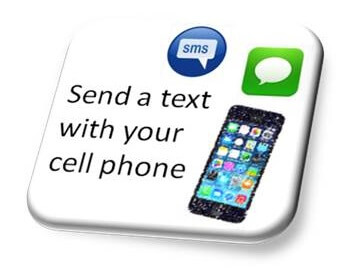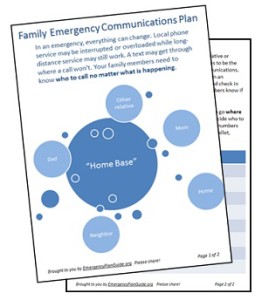Home Base – The Hub of Your Family Communications Plan
In a true emergency, you may have no easy way to communicate.

In a widespread or severe emergency we know that phone communications may be spotty, at best.
An earthquake may cut cables and topple cell towers. A bad storm or hurricane may not cut underground cables, but it can damage all above-ground services including electricity.
For sure, in an extended power outage, even if distant towers and/or satellites are still functioning properly, cell phones and computers will eventually run out of battery. (Yes, yes, if you have solar panels, you may be able to recharge your devices.)
Being cut off from family members is terrifying.
Naturally, you and they imagine the worst. You will be desperate to get in touch.
When local phone service is out, what’s your best course of action?
Reach out to your family’s “Home Base.”
Trying to make a local phone call, whether via landline or cell, may be impossible. However, an outbound long-distance call or text may get through!
This is why we recommend that you talk things over with your family and come up with an out-of-state person who is willing to serve as your “Home Base” – the one place that every family member knows about and tries to contact as soon as possible.
Qualifications for your “Home Base” contact.
Naturally, this needs to be a person you trust. In addition, is your Home Base contact . . .
- Willing to answer the phone day or night?
- Able to take down and forward complete messages from people who may be nervous or even injured?
- Able to receive TEXT messages (cell phone) and EMAIL messages (computer) as well as phone messages?
Remember, family members may be trying to send messages themselves, or they may be asking others (Red Cross, medical personnel, school employees, colleagues, First Responders) to communicate on their behalf. Those other people may have any one of a variety of communications devices.
Your job: Know your family’s Home Base phone number.
In a true emergency, you won’t be able to check your phone contacts on your cell phone or computer. You may not have your address book.
Your children will be in this same situation.
The only thing you can count on is an emergency listing that you carry in your wallet (assuming it hasn’t been lost or ruined) or a number that you have memorized.
Protect your family!
Take the time, as a family, to discuss who your Home Base contact should be, and get their agreement. Discuss safe places you could go if you can’t go home.
Talk about the importance of confidentiality for this information.
Most important of all, make sure all family members memorize the Home Base phone number!
Virginia
Your Emergency Plan Guide Team


